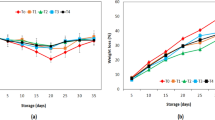Abstract
Effect of blanching time, salt concentration and fermentation on texture of green beans (var. Tuf) was determined. Beans were blanched at 90 °C for 1, 10 or 20 minutes and fermented with brine containing 3.08 and 4.6% salt (corresponding to 1.2 and 1.8% salt in the finished product). The beans were assessed for texture mechanically using Universal Testing Machine (Model 1011, Instron). Sensory evaluation was carried out to assess the taste, texture and overall acceptability of the products. Pectolytic enzyme (pectinestarase and exopolygalacturonase) activities were determined in fresh and fermented beans. Increase in blanching time improved the texture significantly. Significant (p<0.05) decreases in shearing energy of the beans were observed in the first two days of fermentation and, thereafter, there were no significant (p>0.05) changes except for samples blanched for one minute. Salt concentration showed a small but significant effect on texture only in samples blanched for one minute and this was probably due to activation by salt of residual pectolytic enzymes in the beans. Most acceptable beans were those blanched for 20 minutes and fermented with 1.2% salt brine.
Similar content being viewed by others
References
Mwajumwa LBS, Murungi Kahanga E, Imungi K (1991) The prevalence and nutritional value of some Kenyan indigenous leafy vegetables from three locations of Machakos District. Ecology of Food and Nutrition 26: 275.
Vickers Z, Bourne MC (1976) Crispness in foods: A Review. J Food Sci 41: 1153-1157.
Van Buren JP, Mayer JC, Robinson WB (1962) Pectin methylesterase in snap beans. J Food Sci 27: 291-294.
Meurer P (1991) Einfluss pflanzeneigener Enzyme und anderer Faktoren an die Textur fermentierter Gurken. Dissertation. Universität Hohenheim, Germany.
Sistrunk WA, Cain RF (1960) Chemical and physical changes in green beans during preparation and processing. Food Technol 14: 357-362.
Kozup J, Sistrunk WA (1982) Quality attributes of fermented and acidified green beans. J Food Sci 47: 1001-1005.
Chen KH, McFeeters RF, Fleming IHP (1983) Complete heterolactic acid fermentation of green beans by Lactobacillus cellobiosis. J Food Sci 48: 967-971.
Fleming HP, Thompson RL, Bell TA, Honz LH (1978) Controlled fermentation of sliced cucumbers. J Food Sci 43: 888-891.
Thompson RL, Fleming IHP, Monroe RJ (1979) Effect of storage conditions on firmness of brined cucumbers. J Food Sci 44: 843-846.
Hudson JM, Buescher RW (1985) Pectic substances and firmness of cucumber pickles as influenced by CaCl2, NaCl and Brine storage. J Food Biochem 9: 211-216.
v. Klein-Wisenberg A (1978) Kochsalz und Kochsalzersatzmittel aus der Sicht des Chemikers. Akt Ernährungsmed 3: 101-104.
Mnkeni AP, Gierschner K, Maeda EE (1996) Nutritional quality of green beans (var. Tuf) fermented with starter culture. Int J Food Sci and Nutr 47: 35-40.
Staehle-Hamatschek S, Bohrer B, Buckenhuskes H, Gierschner K (1985) Instumentelle Texturmessungen an Einlegegurken. Industrielle Obst-Gemuse-Verwetung 70: 303-309.
Watts BM, Ylimaki GL, Jeffery LE, Elias LG (1989) Basic sensory methods for food evaluation. International Development Research Centre (IDRC-277C) Ottawa, Ontario. Canada.
Doerreich K (1982) Reinigung und Charakerisierung von Pectinesterasc aus einem technischen Peactinenzympraeparat aus Aspergillus niger. Dissertation. Universität Hohenheim, Germany.
Honda S, Nishimura Y, Takahashi K, Chiba H, Kaheld K (1982) A manual method for the spectrophotometric determination of reducing carbohydrates with 2-cyanoacetamide. Anal Biochem 119: 194-199.
Freed R, Eisensmith SP, Reicosky D, Smail VN, Wolberg P (1990) A microcomputer program for the design, management and analysis research experiment. Ed Betsy Bricker. Michigan State Universty.
Steel RGD, Torrie JH (1980) Principles and procedures of statistics, a biochemical Approach, 2nd ed, New York, McGraw-Hill Book Co.
Freenm D, Sistrunk WA (1973) Comparison of steam and water in the blanching of snap beans. Arkansas Farm Research 22: 11.
Sterling C (1955) Effect of moisture and high temperature on cell walls in plant tissues. Food Res 20: 474-476.
Gierschner K (1981) Pectin and pectic enzymes in fruit and vegetable technology. Gordian 7+8: 171-209.
Van Buren JP, Peck NH (1981) Effects of K fertilization and addition of salts on the texture of canned snap bean pods. J Food Sci 47: 311-313.
Van Buren JP (1984) Effect of salt added after cooking on the texture of canned snap beans. J Food Sci 49: 910-912.
Van Buren JP, Kean WP, Wilkson M (1988) Influence of salt and pH on the firmness of cooked snap beans in relation to the properties of pectin. J Texture Studies 19: 15-25.
Sterling C (1968) Effect of solutes and pH on the structure and firmness of cooked carrots. J Food Technol 3: 367-371.
Powell DA, Morris ER, Gidley MJ, Rees DA (1982) Influence of residue sequence on chain association in calcium pectate gels. J Mol Biol 155: 517-531.
Sistrunk WA, Cain RF (1960) Chemical and physical changes in green beans during preparation and processing. Food Technol 14: 357-362.
Summers WI (1989) Pectinestarase and D-Galacturonasc activities in eight snap bean cultivars. HortiScience 24: 484-486.
McFeeters RF, Fleming HP, Thompson RL (1985) Pectinestarase activity, pectin metylation and texture changes during storage of blanched cucumber slices. J Food Sci 50: 201-205, 219.
Bell TA, Etchells JL, Jones ID (1951) Pectinestarase in cucumbers. Arch Biochem Biophys 31: 431-441.
Chunk HK, Chang HG, Park KH, Back BH (1986) Prevention of tissue softening of cucumber pickles by preheating treatment. Res Dept RDA (P.M. & U) 28: 158-164.
Versteeg C (1979) Pectinesterase from the orange fruit, their purification, general characteristics and juice cloud destabilizing properties. Agric Res Reports 892: 2-21.
Omran H, Buckenhuskes K, Jackle E, Gierschner K (1991) Einige Eigenschaften der Pectinestarase, der Exopolygalacturonase und einer endo-beta-Glucanase aus Einlegegurken. Deutsch Lebensmittel Rundschau 87: 151-156.
Izutsu T, Wani K (1985) Food texture and taste. A review. J Texture Studies 16: 1-28.
Author information
Authors and Affiliations
Rights and permissions
About this article
Cite this article
Mnkeni, A., Gierschner, K. & Maeda, E. Effect of blanching time and salt concentration on pectolytic enzymes, texture and acceptability of fermented green beans. Plant Foods Hum Nutr 53, 285–296 (1999). https://doi.org/10.1023/A:1008041222968
Issue Date:
DOI: https://doi.org/10.1023/A:1008041222968




